Reef Information
What makes the coral reefs of the Florida Keys so special? Well, for starters, the Florida Keys Reef Tract is the only living coral barrier reef in North America, and is the 3rd largest coral barrier reef in the world (after the Great Barrier Reef in Australia and the Meso-American Reef in Belieze). The reef runs roughly 221 miles down the south-eastern coast of Florida, paralleling the Florida Keys from Key Biscayne off Miami down to the Dry Tortugas, 70 miles west of Key West, from 1 mile to 8 miles offshore. The proximity of the reef (just a half-hour boat ride from land); the warm, clear water from the Gulf Stream just offshore; and the fantastic richness of life found here makes the reefs of the Florida Keys one of the most uniquely beautiful and accessible wild areas in the country.
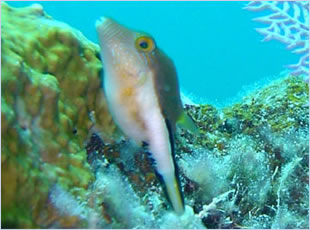 Unfortunately, many visitors to the Keys come down with no real understanding of what a coral reef is! REEF is a general term usually referring to a relatively shallow area of hard structure that tends to attract animals. ALGAE REEFS are found in many areas in the South Pacific, where the primary structure is calcareous algae; ROCK REEFS are common in the Northeastern U.S., where accumulations of granite or other rocky outcroppings have gathered a variety of biofouling organisms and fish to form an active hardbottom community; in many areas, people have even sunk concrete structures, old ships, or railroad cars to form ARTIFICIAL REEFS, which are rapidly colonized by various types of fish and fouling organisms (ex., sponges, tube worms, and hard and soft corals).
Unfortunately, many visitors to the Keys come down with no real understanding of what a coral reef is! REEF is a general term usually referring to a relatively shallow area of hard structure that tends to attract animals. ALGAE REEFS are found in many areas in the South Pacific, where the primary structure is calcareous algae; ROCK REEFS are common in the Northeastern U.S., where accumulations of granite or other rocky outcroppings have gathered a variety of biofouling organisms and fish to form an active hardbottom community; in many areas, people have even sunk concrete structures, old ships, or railroad cars to form ARTIFICIAL REEFS, which are rapidly colonized by various types of fish and fouling organisms (ex., sponges, tube worms, and hard and soft corals).
CORAL REEFS are special because of the community of organisms that build the reef, the HARD and SOFT CORALS. Corals are animals in the Phylum Cnidaria (the group of animals that includes jellyfish and sea anemeones), Class Anthozoa. Corals are found in a variety of forms, from the hard branches of Elkhorn Coral to the soft leaf-like structures of Sea Fans. Corals can generally be divided into SOFT CORALS (Subclass Octocorallia), which have a soft, flexible skeleton of protein (similar to what makes up human fingernails or hair); and HARD CORALS (Subclass Zoantharia, Order Scleractinia), which form a hard exoskeleton of secreted calcium carbonate (limestone). Since the hard corals have a skeleton that is literally rock, it is their growth that really forms the structure of the reef. Each coral head is really a colony of thousands of individual animals called CORAL POLYPS, which look something like upside-down jellyfish.
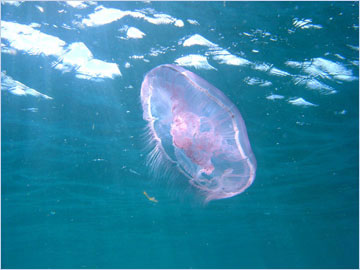 Many who are viewing corals for the first time are surprised at their classification as animals rather than plants, but a closer look clearly reveals actively-moving tentacles and a central mouth, under which lies the simplified digestive tract. Most of these little animals are only around the size of the head of a pin, and are rarely larger than a pencil eraser, but the coral colonies that they form can be the size of a small house! Each coral polyp lives on the outside of the coral head, in a cup or groove in the limestone skeleton. As the coral colony grows and new polyps form through the division of old polyps, each individual coral polyp will lift itself up off the floor of its old cup and will secrete a new calcium carbonate floor underneath it, causing the entire coral head to expand up and outwards. A cross-section of a coral head clearly shows the successive layers formed by each polyp’s growth and expansion outwards. As the polyps move outwards, they leave behind them a dead limestone skeleton, so the only living part on any coral head is the outer 2-3 millimeters. Most hard corals in the Keys grow at a rate of 1/4 - 1/2 inch a year, and it ends up taking about 50 years for a brain coral to grow to the size of a basketball. Branching corals (such as the hard coral Acropora cervicornis, Staghorn Coral) grow somewhat faster, up to 1 1/2 inches a year, but at the price of being much more brittle and prone to damage from storms, ship groundings, or careless divers. Since the soft, jellyfish-like outer layer is the only living part of any coral head, a diver or snorkeler can easily damage or kill a coral merely by touching it! This is the reason behind the Sanctuary Preservation Areas, better known as "No Touch, No Take" Zones.
Many who are viewing corals for the first time are surprised at their classification as animals rather than plants, but a closer look clearly reveals actively-moving tentacles and a central mouth, under which lies the simplified digestive tract. Most of these little animals are only around the size of the head of a pin, and are rarely larger than a pencil eraser, but the coral colonies that they form can be the size of a small house! Each coral polyp lives on the outside of the coral head, in a cup or groove in the limestone skeleton. As the coral colony grows and new polyps form through the division of old polyps, each individual coral polyp will lift itself up off the floor of its old cup and will secrete a new calcium carbonate floor underneath it, causing the entire coral head to expand up and outwards. A cross-section of a coral head clearly shows the successive layers formed by each polyp’s growth and expansion outwards. As the polyps move outwards, they leave behind them a dead limestone skeleton, so the only living part on any coral head is the outer 2-3 millimeters. Most hard corals in the Keys grow at a rate of 1/4 - 1/2 inch a year, and it ends up taking about 50 years for a brain coral to grow to the size of a basketball. Branching corals (such as the hard coral Acropora cervicornis, Staghorn Coral) grow somewhat faster, up to 1 1/2 inches a year, but at the price of being much more brittle and prone to damage from storms, ship groundings, or careless divers. Since the soft, jellyfish-like outer layer is the only living part of any coral head, a diver or snorkeler can easily damage or kill a coral merely by touching it! This is the reason behind the Sanctuary Preservation Areas, better known as "No Touch, No Take" Zones.
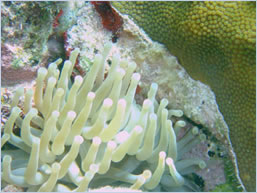 The polyps of hard corals get most of their nutrition from the sun! Each hard coral polyp has within it many single-celled plants, algae called ZOOXANTHELLAE, which give the coral its color (coral tissue itself is completely colorless). The polyps use these zooxanthellae to make most of their food through photosynthesis (each algal cell makes much more food than it needs, and releases the excess food to the coral polyp through oil droplets, a process called "blebbing"); and the rest of their diet comes from active feeding on a mixture of microorganisms suspended in the water colony (phytoplankton and zooplankton). Because of this feeding strategy, hard corals must have clear, shallow water to grow, so that they can get enough sunlight to remain healthy. Corals also tend to be very temperature sensitive, and when the water temperature drops below 68 F or rises above 86 F, the coral-zooxanthellae relationship breaks down (a process called CORAL BLEACHING, because the coral colony turns white) and the coral colony will usually starve and die. Coral’s sedentary lifestyle also requires very high water quality, with a constant flow of new nutrients and dissolved oxygen over the reef. Unfortunately, these very specific conditions only occur in a few places on earth, which is the reason that coral reefs only make up 0.5% of the world’s oceans!
The polyps of hard corals get most of their nutrition from the sun! Each hard coral polyp has within it many single-celled plants, algae called ZOOXANTHELLAE, which give the coral its color (coral tissue itself is completely colorless). The polyps use these zooxanthellae to make most of their food through photosynthesis (each algal cell makes much more food than it needs, and releases the excess food to the coral polyp through oil droplets, a process called "blebbing"); and the rest of their diet comes from active feeding on a mixture of microorganisms suspended in the water colony (phytoplankton and zooplankton). Because of this feeding strategy, hard corals must have clear, shallow water to grow, so that they can get enough sunlight to remain healthy. Corals also tend to be very temperature sensitive, and when the water temperature drops below 68 F or rises above 86 F, the coral-zooxanthellae relationship breaks down (a process called CORAL BLEACHING, because the coral colony turns white) and the coral colony will usually starve and die. Coral’s sedentary lifestyle also requires very high water quality, with a constant flow of new nutrients and dissolved oxygen over the reef. Unfortunately, these very specific conditions only occur in a few places on earth, which is the reason that coral reefs only make up 0.5% of the world’s oceans!
Many coral reefs can easily be classified into one of various types. BARRIER REEFS are those that are found some distance offshore following a shoreline and that come nearly to the surface of the water; these reefs are so named because they tend to form a barrier between the open ocean and the land, and usually cause waves to break on the outside of the reef, leaving a more sheltered area (usually called a LAGOON) behind them. FRINGING REEFS also parallel the shoreline, but closely, often without any lagoon area behind them; in some areas, fringing reefs may grow right up the slope of an island to the low tide mark. BANK REEFS are found offshore, but usually are at a greater distance (frequently open ocean) and are associated with a spot where the bottom raises up from greater surrounding depth; these reefs rarely come as close to the surface and have no protected lagoon. Some open ocean reefs are circular and enclose a shallow lagoon; these are known as ATOLL REEFS, and are often associated with extinct volcanic cones that have subsided below the ocean’s surface. PATCH REEFS are exactly what they sound like: small patchy areas of reef growth, ranging from a few coral heads up to several square miles of coral cover, that are found at various distances offshore and are separated by sand flats and seagrass beds.
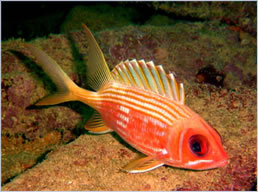 The reefs of the Florida Keys usually span several of these categories. The only reef type not found in the Keys is the atoll! True fringing reefs are rare in the Keys, and are found almost exclusively in the Dry Tortugas, which means that you must take a boat ride if you wish to see the reef. However, the outer reef tract is much closer to shore than many barrier reefs, becoming almost a "fringing barrier reef"; the outer patch reefs are often closer to bank reefs, with the deep water surrounding them, whereas several of the inshore patch reefs are fantastic miniature models of a barrier reef, complete with the protected lagoon area behind them. Although this tends to drive coral researchers to distraction, snorkelers and divers greatly benefit; the Keys provide some of the most unique snorkeling and diving opportunities in the world!
The reefs of the Florida Keys usually span several of these categories. The only reef type not found in the Keys is the atoll! True fringing reefs are rare in the Keys, and are found almost exclusively in the Dry Tortugas, which means that you must take a boat ride if you wish to see the reef. However, the outer reef tract is much closer to shore than many barrier reefs, becoming almost a "fringing barrier reef"; the outer patch reefs are often closer to bank reefs, with the deep water surrounding them, whereas several of the inshore patch reefs are fantastic miniature models of a barrier reef, complete with the protected lagoon area behind them. Although this tends to drive coral researchers to distraction, snorkelers and divers greatly benefit; the Keys provide some of the most unique snorkeling and diving opportunities in the world!
The reef system can also be categorized by "relief," the height that the coral ridges reach above the sand, and once again the Florida Key Reef Tract astounds with its variety. Several inshore reefs are very low-relief and shallow, with the coral growing as a carpet along the bottom and the fish hovering over the top, fantastic for novice snorkelers; other offshore reefs are high-relief, and divers will find themselves cruising down coral canyons surrounded by schools of multicolored wrasses and parrotfish. The depth ranges greatly as well. Several of the inshore reefs have sections that stick out of the water at low tide (these frequently have names ending in "Rocks"). Offshore, the depth ranges from 15 down to 60 or 70 feet over the reef, and if that isn’t deep enough for you, there are several fantastic shipwrecks that have been put down as artificial reefs outside the reef tract; many of these are right at the limits of recreational scuba diving, and most are covered with soft and hard coral growth, multicolored sponges, and schools of large fish.
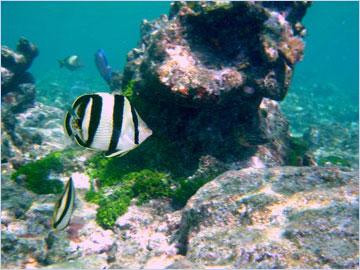 Although the state park waters extend out from shore to the 3-mile limit (this was the first underwater park of any kind in North America!), the majority of the reefs off Key Largo were ceded over to the Key Largo National Marine Sanctuary in 1975, which was then incorporated into the Florida Keys National Marine Sanctuary in 1990. As a result, the reefs that we visit are now under heavier protection (with heavier enforcement of violations!), and are already showing great benefits from this protection! Many of the most sensitive, healthiest reefs are now protected as Sanctuary Preservation Areas, a designation that was put in place July 1st, 1997, to provide additional protection for those areas by making it illegal to fish, lobster, stand, anchor on the reef, or even touch anything within the SPA boundaries. This protection has boosted levels of large gamefish on the reefs and greatly stabilized the overall health of the reef tract while still allowing for eco-tourism activities. Please do your part to protect the reefs when you visit the state park! Respect the boundaries of the SPAs when fishing. Do not stand up on reefs or touch anything while snorkeling or scuba diving (it is our policy to prohibit the use of dive gloves and weight belts on our snorkel boats to discourage this!). While you are in the Keys, remember to shop in an eco-conscious manner as well; in particular, don’t purchase pieces of coral! This coral does not come from our reefs, but it does come from reefs that are in trouble in other parts of the world. We work hard to run an environmentally-friendly gift shop here at the park. Your efforts to protect this fragile marine environment are greatly appreciated!
Although the state park waters extend out from shore to the 3-mile limit (this was the first underwater park of any kind in North America!), the majority of the reefs off Key Largo were ceded over to the Key Largo National Marine Sanctuary in 1975, which was then incorporated into the Florida Keys National Marine Sanctuary in 1990. As a result, the reefs that we visit are now under heavier protection (with heavier enforcement of violations!), and are already showing great benefits from this protection! Many of the most sensitive, healthiest reefs are now protected as Sanctuary Preservation Areas, a designation that was put in place July 1st, 1997, to provide additional protection for those areas by making it illegal to fish, lobster, stand, anchor on the reef, or even touch anything within the SPA boundaries. This protection has boosted levels of large gamefish on the reefs and greatly stabilized the overall health of the reef tract while still allowing for eco-tourism activities. Please do your part to protect the reefs when you visit the state park! Respect the boundaries of the SPAs when fishing. Do not stand up on reefs or touch anything while snorkeling or scuba diving (it is our policy to prohibit the use of dive gloves and weight belts on our snorkel boats to discourage this!). While you are in the Keys, remember to shop in an eco-conscious manner as well; in particular, don’t purchase pieces of coral! This coral does not come from our reefs, but it does come from reefs that are in trouble in other parts of the world. We work hard to run an environmentally-friendly gift shop here at the park. Your efforts to protect this fragile marine environment are greatly appreciated!








